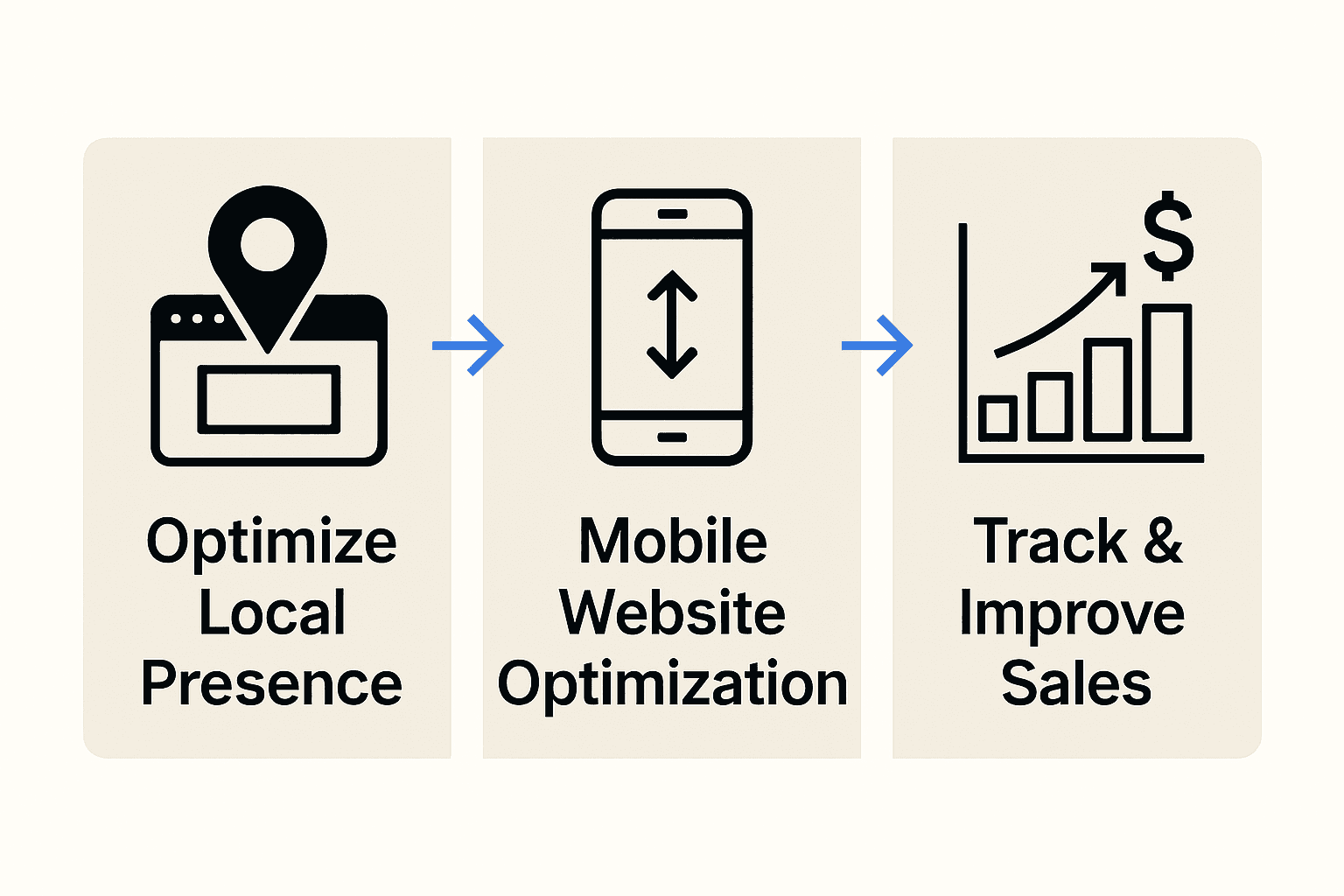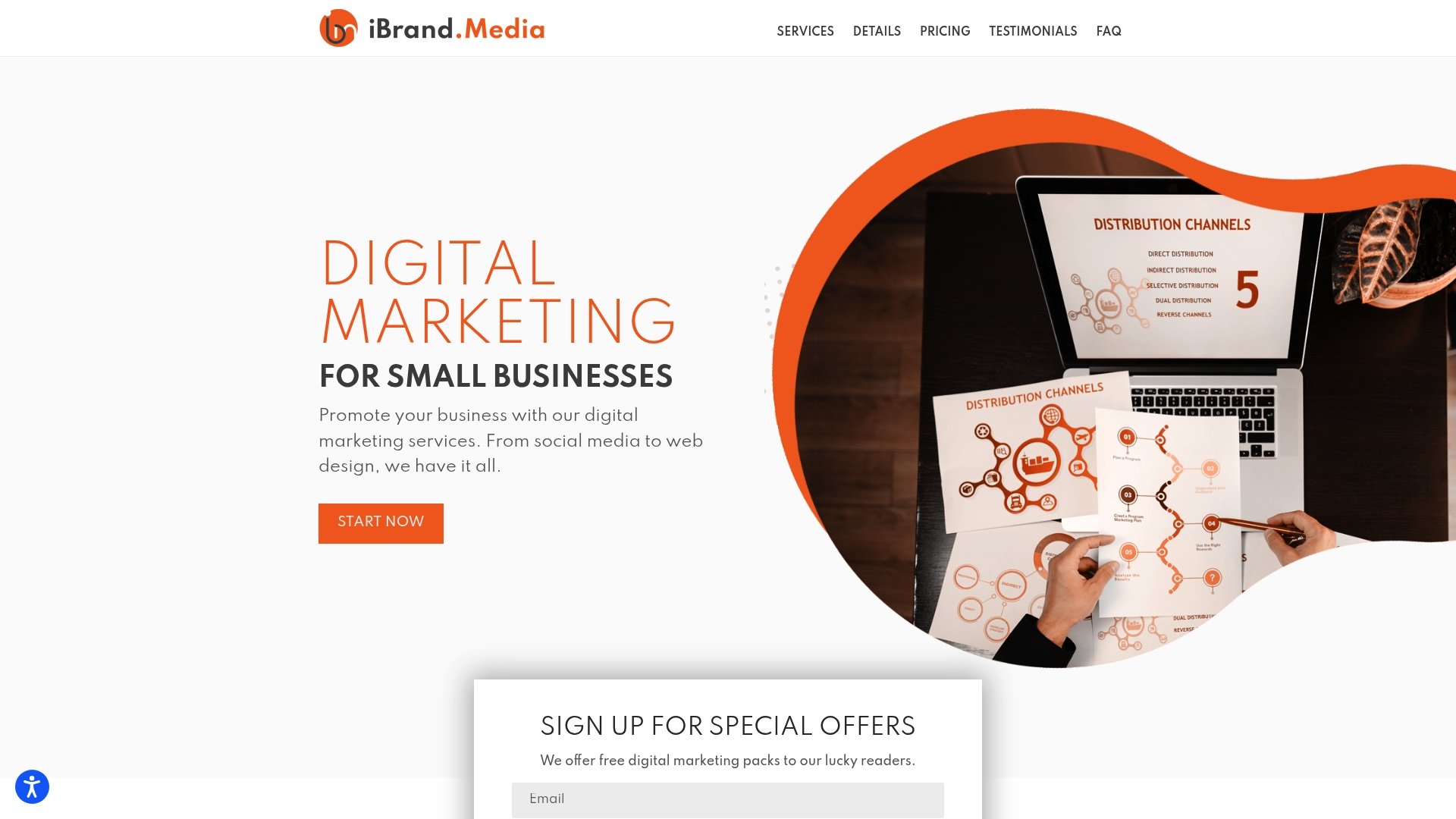More than 80 percent of local customers search online before choosing a business. In a world where digital impressions happen in seconds, your local online presence can make or break new sales opportunities. Learning how to stand out in your neighborhood’s search results is the difference between getting noticed or getting passed by. This guide will walk you through proven steps to help your business attract, engage, and win customers right where they live.
Table of Contents
- Step 1: Assess Local Online Presence And Audience
- Step 2: Optimize Website For Local Search And Mobile
- Step 3: Leverage Localized Paid Advertising Campaigns
- Step 4: Engage Community Through Social Media And Reviews
- Step 5: Track Performance And Refine Sales Strategies
Quick Summary
| Key Point | Explanation |
|---|---|
| 1. Optimize Your Google My Business | Ensure your profile is complete and consistent across all platforms to enhance local online visibility. |
| 2. Develop a Mobile-Responsive Website | Create a website that adjusts to various devices, ensuring a seamless user experience across smartphones, tablets, and desktops. |
| 3. Use Localized Paid Advertising | Target ads geographically to reach customers in specific areas, enhancing engagement and conversion rates. |
| 4. Engage with Community on Social Media | Create a strong online presence by interacting with local customers and sharing relevant community-focused content. |
| 5. Regularly Track and Analyze Performance | Use analytics tools to monitor key metrics like conversion rates and customer behavior for continuous strategy improvement. |
Step 1: Assess Local Online Presence and Audience
Assessing your local online presence helps you understand how potential customers find and perceive your business. This step involves analyzing your current digital visibility and understanding your target local market demographics and search behaviors.
Start by conducting a comprehensive digital audit. According to ijsrset, optimizing your Google My Business profile is crucial for enhancing local online visibility. Search for your business name and check what information appears across different platforms. Are your business details consistent? Do you have complete profile information on Google, Yelp, and other local directories?
Next, analyze your local audience. Research from scirp emphasizes the importance of incorporating local keywords that resonate with your specific geographical community. Use tools like Google Analytics and social media insights to understand:
- Age ranges of local customers
- Primary geographic locations
- Peak online activity times
- Most viewed content or services
These insights will help you tailor your online marketing strategy more precisely. Remember that understanding your local digital footprint is not a one-time task but an ongoing process of refinement and adaptation.
In the next step, we will transform these insights into a targeted online strategy that connects directly with your local audience.
Step 2: Optimize Website for Local Search and Mobile
Optimizing your website for local search and mobile devices is crucial for attracting and retaining local customers in today’s digital landscape. This step focuses on transforming your online presence to be more accessible and appealing to local mobile users.
According to ijfmr, developing a mobile-responsive website is essential for local businesses. Your website should automatically adjust to different screen sizes, ensuring a seamless experience whether customers are browsing on smartphones, tablets, or desktops. Start by using responsive design techniques that adapt your layout, images, and content dynamically. Prioritize large, easy to read fonts, touch-friendly buttons, and streamlined navigation that works smoothly on mobile devices.
Research from ijfmr highlights the critical importance of website loading speed for user engagement. Optimize your site’s performance by:
- Compressing image files
- Minimizing complex scripts
- Using browser caching
- Implementing content delivery networks
Incorporate local keywords naturally throughout your website content. This means mentioning your city, neighborhood, or region in page titles, headings, and descriptions. Understanding local SEO ranking factors can help you refine this approach and improve your local search visibility.
By creating a mobile-friendly website that speaks directly to your local audience, you set the stage for increased online engagement and potential sales conversions.
 The next step will help you leverage local advertising strategies to further amplify your online presence.
The next step will help you leverage local advertising strategies to further amplify your online presence.
Step 3: Leverage Localized Paid Advertising Campaigns
Localized paid advertising campaigns help small businesses target potential customers precisely where they live and engage with their online content. This step will guide you through creating strategic digital ads that maximize your local market reach and drive meaningful conversions.
According to arxiv, efficient optimization algorithms can dramatically improve web page content for local advertising campaigns. Start by identifying your specific target audience within your local area. Use platforms like Google Ads and Facebook Ads to create geographically targeted campaigns that reach customers in specific zip codes, neighborhoods, or radius around your business location. How to Run Local Ads can provide additional insights into crafting these precise targeting strategies.
Research from arxiv emphasizes the importance of mobile web performance in advertising effectiveness. When designing your local ad campaigns, focus on creating mobile-friendly content that loads quickly and provides a seamless user experience. Your advertising strategy should include:
- Compelling local imagery
- Clear value propositions
- Mobile responsive design
- Location specific messaging
- Quick loading graphics
Prioritize creating ads that speak directly to local customer pain points and showcase how your business uniquely solves their problems. By combining precise geographic targeting with compelling content, you transform paid advertising from a cost center into a powerful customer acquisition tool.
In the next step, we will explore how to track and measure the success of these localized advertising efforts to continuously improve your strategy.
Step 4: Engage Community through Social Media and Reviews
Engaging your local community through social media and reviews is a powerful strategy to build trust, increase visibility, and attract new customers. This step will help you transform online interactions into meaningful connections that drive business growth.
According to jetir, optimizing your Google My Business listing and encouraging positive customer reviews are critical for local SEO enhancement. Create a consistent posting schedule across platforms like Facebook, Instagram, and LinkedIn that showcases your business personality. Engaging Your Local Community Online can offer additional strategies for creating genuine connections.
Focus on developing content that resonates with your local audience. This means sharing behind the scenes glimpses of your business, highlighting local events, and featuring customer success stories. Your social media strategy should include:
- Responsive customer interaction
- Authentic local storytelling
- User generated content
- Community focused posts
- Regular review management
Encourage satisfied customers to leave reviews by making the process simple. Send follow up emails with direct review links, display review links prominently on your website, and always respond professionally to both positive and negative feedback. By actively managing your online reputation, you transform casual followers into loyal community advocates.
In the next step, we will explore how to analyze and refine your local marketing efforts for continuous improvement.
Step 5: Track Performance and Refine Sales Strategies
Tracking and refining your digital marketing performance is crucial for sustainable business growth. This step will help you transform raw data into actionable insights that continuously improve your local online sales strategy.
According to en, collecting and analyzing user behavior data provides critical information for performance tracking. Leverage tools like Google Analytics, Facebook Insights, and Google Search Console to monitor key performance indicators. Tracking Digital Marketing Success can provide additional guidance on interpreting these metrics effectively.
Focus on tracking metrics that directly impact your business goals. Your performance monitoring strategy should include:
- Conversion rates
- Website traffic sources
- Customer acquisition cost
- Engagement rates
- Click through rates
- Revenue per marketing channel
Set up regular monthly or quarterly review sessions to analyze these metrics. Look for patterns in customer behavior, identify which marketing channels deliver the best results, and be prepared to pivot your strategy quickly. By treating data as a dynamic roadmap rather than a static report, you can continuously optimize your marketing approach.

In the final step, we will explore how to sustain and scale your local online sales strategy for long term success.
Take Your Local Online Sales to the Next Level Today
Struggling to connect with your local customers and boost sales online? This guide highlights how important it is to optimize your website for mobile, use local keywords, and run targeted ads that speak directly to your community. If you are overwhelmed by managing multiple digital marketing tasks or unsure how to track your performance effectively, you are not alone. Many small businesses face these exact challenges of building a strong local online presence that drives real revenue.
At ibrand.media, we specialize in working alongside SMBs to solve these problems with affordable and tailored strategies. From mobile-friendly web design and local SEO to focused paid advertising and social media engagement, our services cover every step needed to grow your local market share. See how we translate insights into action by visiting our Uncategorized | Ibrandmedia page for case studies and useful resources.

Ready to stop guessing and start converting local customers quickly? Partner with us now to create a personalized plan that turns your online presence into a powerful sales engine. Take your first step by exploring ibrand.media or browse more helpful tips at Uncategorized | Ibrandmedia. Your local sales growth starts here.
Frequently Asked Questions
How can I assess my local online presence?
To assess your local online presence, conduct a digital audit by searching for your business name and evaluating how information appears across different platforms like Google and Yelp. Ensure your business details are consistent and your profiles are complete for better visibility.
What are effective strategies for optimizing my website for local search?
To optimize your website for local search, incorporate local keywords related to your community in page titles, headings, and content. Also, ensure your site is mobile-responsive and loads quickly to enhance user experience and improve local search ranking.
How do I create localized paid advertising campaigns?
Create localized paid advertising campaigns by utilizing platforms that allow geographic targeting such as Google Ads and Facebook Ads. Focus on crafting mobile-friendly ads that are specifically tailored to address local customer needs and showcase your business’s unique offerings.
What types of content should I share on social media to engage my local community?
Share content that resonates with your local audience, such as behind-the-scenes glimpses of your business, local events, and customer success stories. Consistently interact with your followers and encourage user-generated content to build a strong community connection.
How can I measure the success of my local online sales strategy?
To measure the success of your local online sales strategy, track key metrics like website traffic, conversion rates, and customer acquisition cost. Set up monthly reviews to analyze these metrics and adjust your strategy based on what’s working effectively to enhance your sales efforts.
How often should I refine my local marketing strategies?
Regularly refine your local marketing strategies by conducting monthly or quarterly reviews of your performance metrics. Look for trends in customer behavior and be prepared to make quick adjustments to optimize your approach and improve your sales outcomes.

Recent Comments